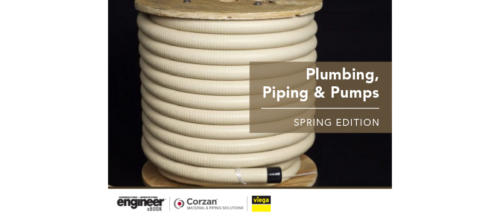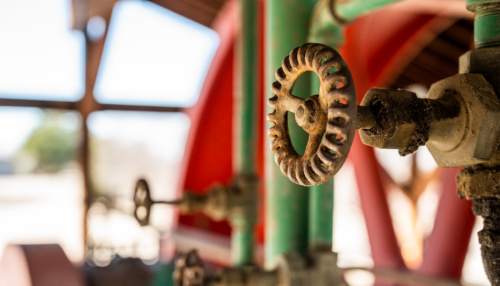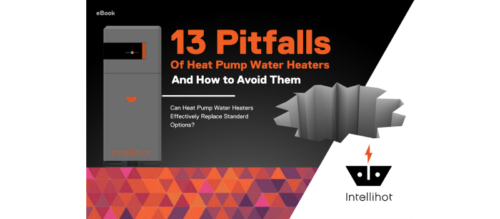Details on how ASHRAE 90.1 affects the plumbing engineer
Additional topics were covered by the webcast speaker on how plumbing engineers should interpret ASHRAE 90.1 when specifying pumps and drives.
Attendees of the webcast on ASHRAE Standard 90.1—What this means to the plumbing engineer had several questions that the presenter answered after the live event. Watch the webcast on-demand for additional information.
Question: Which is better: Using constant speed pumps set for high-rise in pressure build-up sequence at high demand or using variable speed pumps set to vary the water per the demand?
Reece Robinson: Constant speed pumps can be considered a "better" choice over variable speed pumps if the flow remains relatively constant and the pump is operating at or near its best efficiency. A high-rise example would be water transfer to a storage tank. Tall buildings such as the John Hancock building in Chicago have a water storage tank near the middle floors (50th floor, for example). The storage tank supplies the lower half of the building (gravity feed down) and also supplies water to a second set of pumps supplying the upper floors. The feed pumps at the bottom of the building switch on to refill the storage tank mid-way up the building and run at a fairly constant flow rate.
Question: Is trimming impellers necessary with variable frequency drives (VFDs)?
Reece Robinson: In most cases it is more energy efficient not to trim impellers when VFDs are used. When in impellers is trimmed the pump efficiency is decreased. However, leaving an impeller at its full diameter can result in a larger motor and subsequently larger VFD, which results in a higher installed cost. A full diameter impeller may be one or two motors/VFD sizes up from what the design flow/head call for. A lifecycle cost analysis will show whether the added investment will have an attractive rate of return.
Question: If ASHRAE Standard 90.1 dictates that there is no pressure change, how will tanks be effective?
Reece Robinson: The standard does not state that there shall be no pressure change. The standard states that no device(s) shall be installed for the purpose of reducing the pressure of all of the water supplied by any booster system. Many interpret this as requiring systems to be "constant pressure" variable speed systems. The energy code is simply discouraging the use of pressure regulator valves as a means to control the output pressure of pumps as this method has been proven to be inefficient.
Question: In a high-rise building, how is the pressure controlled by zone?
Reece Robinson: High-rise buildings are a bit tricky when it comes to delivering ample water pressure. It is generally more energy efficient to divide tall buildings into two or three pressure zones. This means that there will be 2 or 3 booster systems: one for the low zone, one for the middle zone, and one for the high zone. For example, a 100-story building the low zone would be floors 1 to 32, the middle zone would be floors 33 to 67, and the high zone would be floors 68 to 100. If one pump system were to be used, the output pressure from the system would be in excess of 450 psig to get water to the top of the building. This would require a large amount of pressure regulator valves (PRVs) on the lower floors, many of them rated for very high working pressures, which will drive up costs, both initial and maintenance. Increasing the number of pump systems decreases the number of pressure regulator valves required. You cannot avoid using PRVs in high-rise buildings altogether, but you can reduce that number by increasing the number of pumps. The lower floors of each zone will have PRVs that serve each floor because the delivery pressure of each pump system will be well over what is required by the consumers.
Question: Is a flow meter needed for either linear or square control curve?
Reece Robinson: That depends on the pump system control logic. Some manufacturers have pump curve data loaded into the controller and can calculate an approximate flow rate by measuring the differential pressure across the pump. Using a flow sensor will more accurately depict a linear or squared control curve.
Question: What is the distance from a fitting to a pressure transducer recommended?
Reece Robinson: For most pressure transmitters used in the industry today, there’s no minimum spacing from fittings etc. as long as the area around the sensor is completely water. Things like air or air bubbles caused by cavitation should be taken into consideration for sensor placement.
Question: Why a diaphragm tank, and not a bladder type?
Reece Robinson: For the presentation, I might have used the terms bladder and diaphragm interchangeably. For the purpose of storing water to allow a pump to stop, both can be used. The bladder type tanks have a higher acceptance volume whereas the diaphragm type tanks have a limited acceptance volume; however, both will have a pressurized air pre-charge allowing for water storage.
Question: How many starts and stops allowed per hour if water demand is on/off quite often? Will I burn the motor?
Reece Robinson: The allowed starts and stops will depend on the inertia of the pump.
Question: Why is the bladder tank located in the discharge? Can we install it on the suction?
Reece Robinson: For purposes of energy savings via a pump shutting down, the bladder tank must be installed after the pump. In heating systems, it is common to see expansion tanks installed on the suction side of pumps for different reasons apart from energy savings.
Question: Is a flow meter needed to determine low/no flow condition?
Reece Robinson: Yes and no; it depends on the pump system controller. A flow switch can sometimes be used as well as advanced pump logic.
Question: For the example, how many stops per hour is allowed for the pump motor? How does this square with the code requirement that might destroy the motor?
Reece Robinson: For the example shown, using the 1.5 hp motor, the allowed starts per hour were well over 200 based on the inertia of the pump. That of course if based on across the line starting, but in this case the motor was starting via a VFD for which there is no starting current. In essence the allowed starts per hour will be higher when using drives. There is no code limitation that I am aware of two starts per hour using VFDs. It would be best to consult the pump system manufacturer and/or motor manufacturer.
Question: How do the many starts per hour affect the pump life?
Reece Robinson: It is best to consult the pump manufacturer. In general pumps with low inertia can withstand hundreds of starts per hour exceeding the motor limits.
Question: What is the normal operating conditions for bladder to set it up at minimum and maximum pressure?
Reece Robinson: That depends on the pump control logic. For variable speed systems it is typical to see an air pre-charge pressure in the 70% to 80% range of system pressure. For example if the system pressure set-point was 100 psig, the tank air pre-charge would be 70 to 80 psig.
Question: Does the on/off affect the life of the equipment?
Reece Robinson: A very good question. The interesting part is that the allowable starts per hour discussed in the presentation was based on across the line starting where you have 5 to 10 times full load current. When using VFDs there no starting current at all. The drive will start the motor at zero current and ramp up to a value at or less than full load current. Because the motor is connected to a drive there is no motor starter (contactor coil). Excessively cycling a starter on and off may limit the lifetime of that electrical component, but because starters are not needed with VFDs, that’s one less thing to worry about.
Question: Do you have to have significant "off" time to prevent early motor winding failure due to heat from rapid cycling?
Reece Robinson: Agree, however with low inertia loads the heat generated in the motor during starting will be less than what the motor is designed for.
Question: Do your inertia numbers include the inertia for the water? What about the soft start effect of the VFD ramping?
Reece Robinson: The figures used for inertia only included the pump. It was used to show a relative comparison. With the soft start effect of the VFDs, there is no starting current at all so heat generated during starting should be less with the drive thus resulting in an even higher starts per hour allowance.
Question: Did you say that multistage pump has less inertia compared to single-stage pump? If so, why? I thought multistage pumps are for generating high pressure and hence will they not have higher inertia?
Reece Robinson: For the same flow and head requirement, multi-stage pump impellers are much lower in diameter and mass than single stage impellers. This is especially true when the multi-stage pumps are constructed using sheet stainless steel impellers.
Question: How is the size of a diaphragm tank determined?
Reece Robinson: It is best to consult the pump system manufacturer when determining tank size as this is in part based on the control logic.
Question: Is the recommended location of the bladder tank at the pump assembly or at the most remote location in the system, i.e. in the mechanical penthouse?
Reece Robinson: Ideally, the tank location is close to the sensor location, however systems have operated successfully with roof-mounted tanks and system-mounted sensors. It is best to consult the pump system manufacturer during the design process. Tanks are also mounted at higher floors to keep the installation costs down. If a diaphragm/bladder tank working pressure exceeds 150 psig ASME code tanks are usually required. If mounted at the top of a building, a less expensive non code tank can be used because it only needs to be rated at 125 to 150 psi.
Question: Please expand on the location of the remote sensor. What is the optimum location? Is there a "rule of thumb" for location? In your experience how successful, typically, is the design indicated location? Finally, is this perhaps not best field located by trial and error?
Reece Robinson: The best sensor location is based on the complexity of the system design so there is no "rule of thumb." It is best to consult with the pump system manufacturer during the design process. It also helps if the pump system has the flexibility to operate with either a local or remote sensor and can easily be switched from one to another with a simple control logic adjustment. From a design perspective, consider installing a provision for one or two alternate sensor locations (via a 0.25 in. National Pipe Thread (NPT) sensor tap along with easy access to building management system or pump control logic).
Question: The tank must be pre-charged to the system pressure; you stated the pre-charge was 25 psi was than system pressure in your example. Doesn’t this violate Boyles Law and how it applies to the use of a hydro tank?
Reece Robinson: In the example shown the system pressure was 75 psi and the pre-charge pressure was 50 psi, or 67% of system setpoint. So with 50 psig of air pressure, this will allow the bladder to hold a small amount of water when the pump increases the system set-point to 79 psig.
Question: If piping splits to feed two different zones, how does control logic account for that?
Reece Robinson: That depends on the control logic being used. If the piping splits into two zones and the flow/head requirements for each zone are similar, that will have little effect on the pump control. If the two zones are quite different, a careful look at controls and sensor location should be evaluated.
Question: Are flow-through bladder tanks recommended to further reduce the possibility of bacteria growth?
Reece Robinson: If the pressure in and around a bladder tank remains constant to where the water inside the bladder is not evacuated, then yes, I would say a flow-through tank would help reduce the possibility of bacteria growth. For systems that encounter low flow, using an on/off energy saving control mode shown in this presentation will ensure that the water is evacuated out of the bladder regularly, thus reducing the likelihood of bacteria growth.
Question: Isn’t the best method of control system pressure to actually install the system sensor at the end of line instead of predicting/calculating this value (linear prediction or squared prediction)?
Reece Robinson: Yes, in most cases the remote mounted sensor will result in the highest energy savings as the "true" system resistance is being realized. It is possible that the remote sensor location selected was not the best choice. For reasons other than energy savings and in cases like that, it is best to have provisions to switch sensor locations or use pump control logic with the remote sensor simulation software.
Do you have experience and expertise with the topics mentioned in this content? You should consider contributing to our CFE Media editorial team and getting the recognition you and your company deserve. Click here to start this process.




